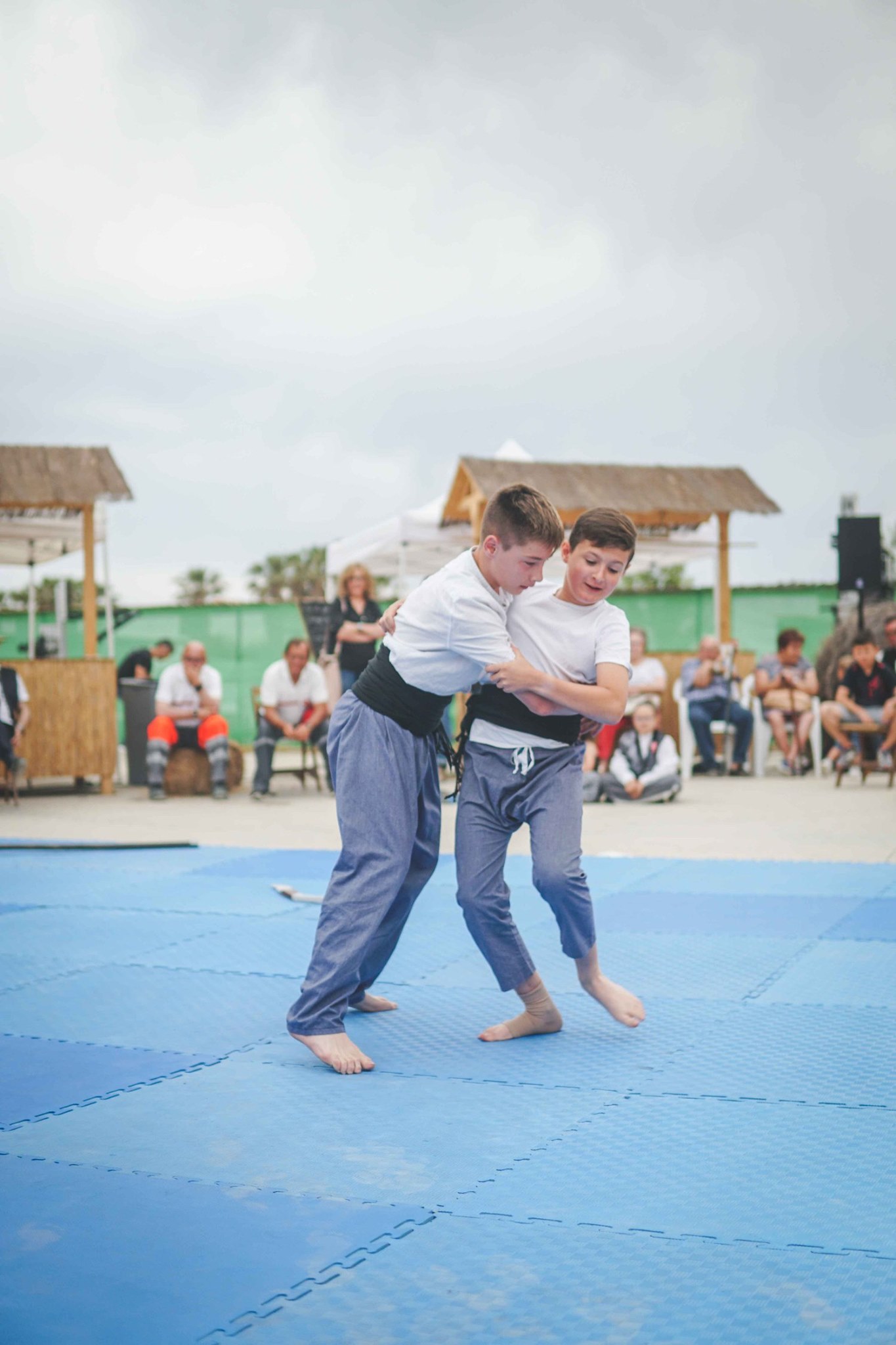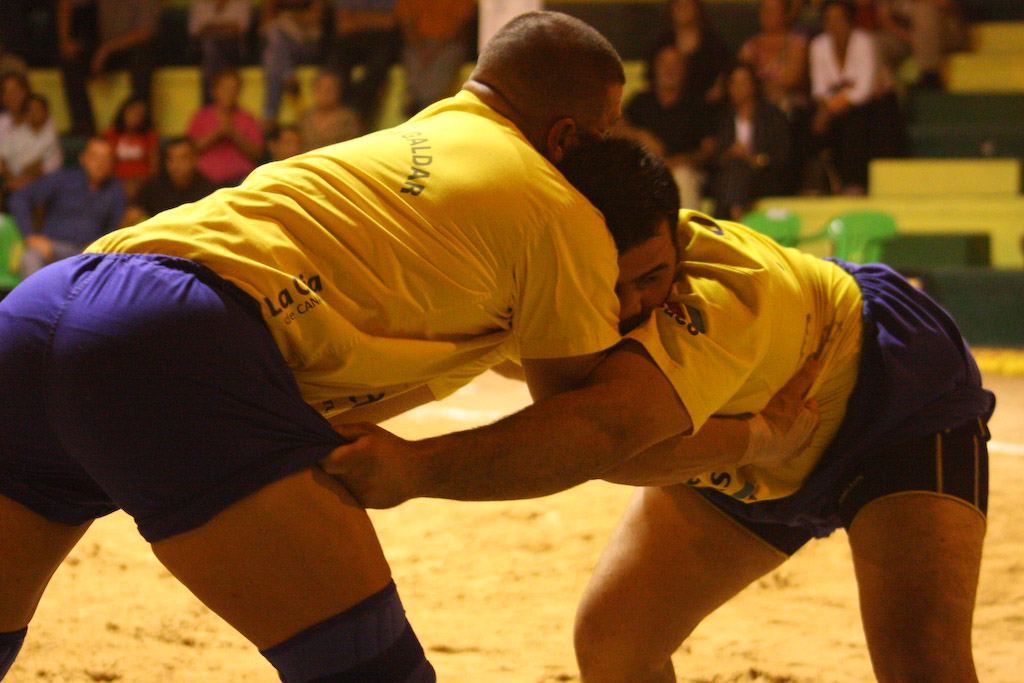- Name of sport (game): Lanzamiento de Barra Vasca or Lanzamiento de Palanka Vasca
- Name in native language: Lanzamiento de Barra Vasca or Lanzamiento de Palanka Vasca (palanga, balenka, balenga, barra, barraka, satsi, burdin-barra edo burdiñ-aga)
- Name of sport (game): Lelo Burti
- Place of practice (continent, state, nation):
Georgia
- Description:
Lelo Burti literally means ‘field ball’. It originated from the time of the Ottoman Empire when, according to legend, a large Ottoman army was defeated by a small group of Gurian troops. Since then the game is played in commemoration of the event.
Although the game is commonly known as ‘rugby without rules’, some do exist:
Players are divided into two teams: Zemo (upper) Shukhuti and Kvemo (lower) Shukhuti. There is no set number of players – the bigger the better, as it increases the chances of winning.
The game is played with a ball which is filled with sand and dirt, soaked with wine and sown shut before the event. It should weigh approximately 16kg.
The game starts in the centre of the village, and players have to carry the ball over to one of the streams on the opposite side ( approximate 500 meters away from each other). Everything between the streams form the game area, including courtyards and orchards.
Once the ball crosses the stream the game is over. The winners have the privilege to carry the ball to the grave of a respected member of the community who died the year before.
In the event of an injury, participants raise their hands which is a sign to pause the game and take the injured to safety. It works in most cases.
Players can’t be under the influence of alcohol.
Event preparations start long before the time. Everyone, including cultural and sport managers are involved in preparing competitions. Kids exercise, choirs and bands have rehearsals, while local entrepreneurs prepare their products.
Source: https://jam-news.net/lelo-burti-a-different-kind-of-ball-game/ - Sources of information :
- Name of sport (game): Letoussi
- Place of practice (continent, state, nation):
Bulgaria
- Name of sport (game): Levantamiento de Arado
- Name in native language: Levantamiento de Arado
- Place of practice (continent, state, nation):
Canary Islands
- History:
Its origin is related to the need of the human being to measure his strength, using for it, the materials that he finds in his environment.
After the Conquest, new ways of exploiting the land came to the Island, which meant the introduction into the agricultural landscape of a new element: the Roman-type plow.
With the plow, el Canario (A resident of the Canary Islands) created a curious practice consisting of lifting said element, in a show of strength and skill. This was done at rest time, after plowing.
It was also the case that in agricultural areas, after the work or slaughter, there were exhibitions of lifting the plow, as well as Canarian fighting.
This sport modality is clearly a test of strength and skill. The promoter of this sport was the famous wrestler Don José Rodríguez Franco (1912-1991) better known as el Faro de Maspalomas. - Description:
The lifting technique consists of two foundations: physical strength and dexterity, also called "geito" or "maña".
Hand placement is important because uncontrolled force can seriously injure the lifter. One of the hands is placed at one end with the palm down, which is directed as if it were a kind of rudder, while the other is placed more forward with the palm up, providing the necessary balance to combine movements.
The legs must be supported in the direction of the grate. The lift is started by lying backwards as a counterweight to the plow.
The work of the arms and the use of the thigh as a support point for the realization of the lever, are essential in the lifting task.
The descent of the plow is also very important because it cannot be lowered abruptly, since this supposes an imbalance of forces that can cause a blow to the athlete.The plow consists of the following parts: Timón (ruder), Cabeza (head), Yugo (yoke), Frontiles, Guijada and Reja.
Timón: it is a pole four meters long with a diameter of 0.10 meters. At one end it conforms to the head, and that is what the earth is plowed with.
Yugo: is a piece of wood that fits the neck of cows or oxen to pull the plow.
Plows vary depending on the land to be plowed and the draft animal in question.
The average measurement ranges between 4.5 and 5 meters in length, its weight is around 70 kilograms, plus the yoke, the gable and the guijada.
After the glory days, given by Don José to the Canarian public, the new generations took over, among them are Cástor Castro Morales who not only agrees to lift the plow but also usually places one end of it in the chin and when it descends the plow is placed at half height, greeting the public with it.
On the other hand is Santiago Santana Rodríguez, grandson of El Faro. He started at the young age of 12 watching his grandfather's displays. Santiago among other particularities when lowering the plow makes a 360 degree turn at half height in order to greet the public. - Current status:
In recent times, lifting the plow has been incorporated into indigenous Canarian sports, exhibiting it at fairs and congresses of indigenous sports.
- Name of sport (game): Bac wrestling
- Name in native language: Lluita del bac ( catalan)
- Place of practice (continent, state, nation):
This traditional wrestling is practiced in the region of the end of the Ebro river, in the province of Tarragona in the autonomous community of Catalonia, Spain
- History:
We are currently studying its history, we know that it was practiced in our area and in Valencia at the end of the 19th century but we do not know since when it began and its exact origins.
There were two ways in the Bac struggle, closely related and complementary to each other. On the one hand, for the defense staff, all sorts of techniques were practiced that included blows with any part of the body (fists, feet, knees, elbows, head ...), dislocations in the limbs, pinching in sensitive areas and takedowns. Also the use of traditional tools as weapons. As well as learning to defend against attacks with these tools.
On the other hand, fights were practiced in the form of impromptu challenges, in which rules were usually agreed upon at previous moments, however they used to have as a common feature that who made to fell on the contrary wins. The most potentially harmful techniques, such as blows and dislocations, were forbidden. - Description:
In sport, the association has currently drawn up regulations. The summarized rules are:
- The two fighters embrace without letting go trying to bring the other to the ground.
- If you fall to the ground with your whole shoulder, there are two points for your opponent, if you fall to the side or in any other way he gets a point.
- Win the first one to reach 4 points or the one with the most points at the end of the time (2 or 3 minutes depending on the category) - Current status:
Although the Bac fight was rooted in the traditions of the Ebro Lands and, until the first half of the 20th century, it was a general practice, even forming part of the usual repertoire of children's games throughout the territory, the lack of an organization and regulations made the practice decline until its near disappearance, remaining only maintained by a small number of people. One of them, MR. Juan Jose Valldeperez Casanova (knowledgeable and conservative of Bac, as well as a teacher of karate, jujitsu and Greco-Roman wrestling) included Bac in the training program of the karate clubs in which he taught. In this way, he got the Bac fight to be practiced again within the scope of the kushinkai karate clubs of Camarles, Deltebre and San Jaume d'Enveja. And later he was joined by the Kushinkai club in Sant Carles de la Ràpita.
These clubs regularly organize Bac exhibitions within the framework of the traditional rice festivals that are held annually in the delta area and also on the occasion of the local festivals of the municipalities. Likewise, these clubs have been organizing Bac children's competitions periodically from 2010 to the present.
In 2015, these sports clubs began the procedures for the Bac to be registered in the list of recognized physical-sports leisure activities and registered in the Registry of Sports Entities. On October 6, 2016, the Catalan Sports Council approved the inclusion of Bac in the registry. From there, the procedures for the creation of the Associació de Lluita del Bac de les Terres de l’Ebre (in Catalan) could be started. These procedures were delayed due to the pandemic, but the association made up of the aforementioned karate clubs has recently been established. - Importance (for practitioners, communities etc.):
We are currently about 100 people who practice and spread this style of wrestling. The government of Calunya has recognized this style of wrestling as a sport and there is a growing interest from different agencies and media.
We are in the process of recovery. this style of wrestling had been abandoned and currently several martial arts clubs in the area have created the association to recover and promote this beautiful tradition.
- Contacts:
Associacó de la Lluita del Bac de les Terres de l’Ebre
President: Miguel Castro Casanova
Secretari: Juan Antonio Roman LLambrich
- Sources of information :
Articles:
https://www.tornaveu.cat/noticia/5746/la-lluita-de-bac-les-arts-marcials-catalanes
http://hemeroteca.marfanta.com/noticia/Sant_Jaume_vol_recuperar_la_lluita_lliure_ebrenca/9350Video:
https://tac12.alacarta.cat/horaridestiu/tall/voleu-coneixer-la-lluita-al-bac
https://www.facebook.com/1636664417/videos/416194486701510/The information contained in the article comes from the following sources:
Associacó de la Lluita del Bac de les Terres de l’EbreSource of photos used in this article and gallery:
Associacó de la Lluita del Bac de les Terres de l’Ebre - Gallery:
- Name of sport (game): Lucha Canaria
- Name in native language: Lucha Canaria
- Place of practice (continent, state, nation):
Canary Islands (Spain)
- History:
Lucha Canaria comes from the Guanches, the earliest known natives of the Canary Islands, however, with limited contact between the archipelago, each island developed different rules.
In 1420, after the Spanish conquest, Alvar García de Santa María, first registered the wrestling techniques, including the use of referees. Only some of these early rules and techniques have survived to modern times. After the conquest, the sport became part of the islands’ tradition, usually being fought at celebrations or local festivals. The rules were established in 1872, making it one of the earliest defined forms of wrestling
The rules have been passed on from generation to generation for centuries. The genesis of discipline dates back to the earliest history of the archipelago. According to the chronicles, it appeared in the XV century during conquests. However, originally it was not the struggles of athletes, but one of the methods of resolving conflicts, which was based on respect for the opponent, or a good way to prepare for the war. Later, the fight became a part of religious ceremonies. During emigration, the inhabitants of Kanar spread it in Cuba and Venezuela. The key moment of the existence of sport was the establishment in 1943 of the Federación de Lucha Canaria.
In the 1940s several provincial federations were formed, leading to the formation of the Federación Española de Lucha in 1984. As it needs a sand circle, lucha is usually fought on special pitches, and important matches, particularly inter-island contests, are covered by local Canarian TV.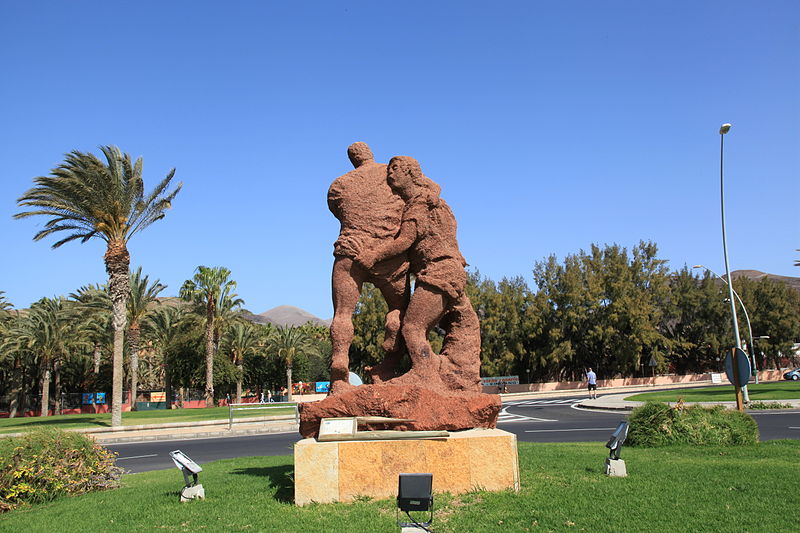
Homenaje a la Lucha Canaria by Juan Miguel Cubas, Avenida del Saladar in Morro Jable, Pájara, Fuerteventura, Canary Islands
- Description:
Players fight on a terrero, that is a round arena covered in sand. Teams consist of 12 people, and individual fights are in pairs. The goal of two players struggling with each other is to knock down the rival (it is enough to touch the ground with a different part of the body than the foot), for which one point is scored. The elimination is when the opponent is overturn twice. For this purpose, various techniques are used, such as donkey, cango, criminal throw, emptiness, tripping, muscle grip, toss, etc. The fight requires not only strength but also agility from the athlete. Tactical thinking, or even cunning, is important. Those who are able to defeat more than one opponent during the struggle are called puntales. A defeated player can offer his hand of the rival who escorts him from the ring in a respectful way, which also shows the nobility of the discipline.
Techniques using in Lucha Canaria:
Grasping: The wrestler may grasp any part of the opponent's body to try to unbalance and knock down the opponent.
Block: The wrestler can block a move by his opponent, and use his strength to unbalance his opponent.
Deflect: The wrestler can move his body to deflect a move by his opponent, and use the opponent's strength to unbalance him.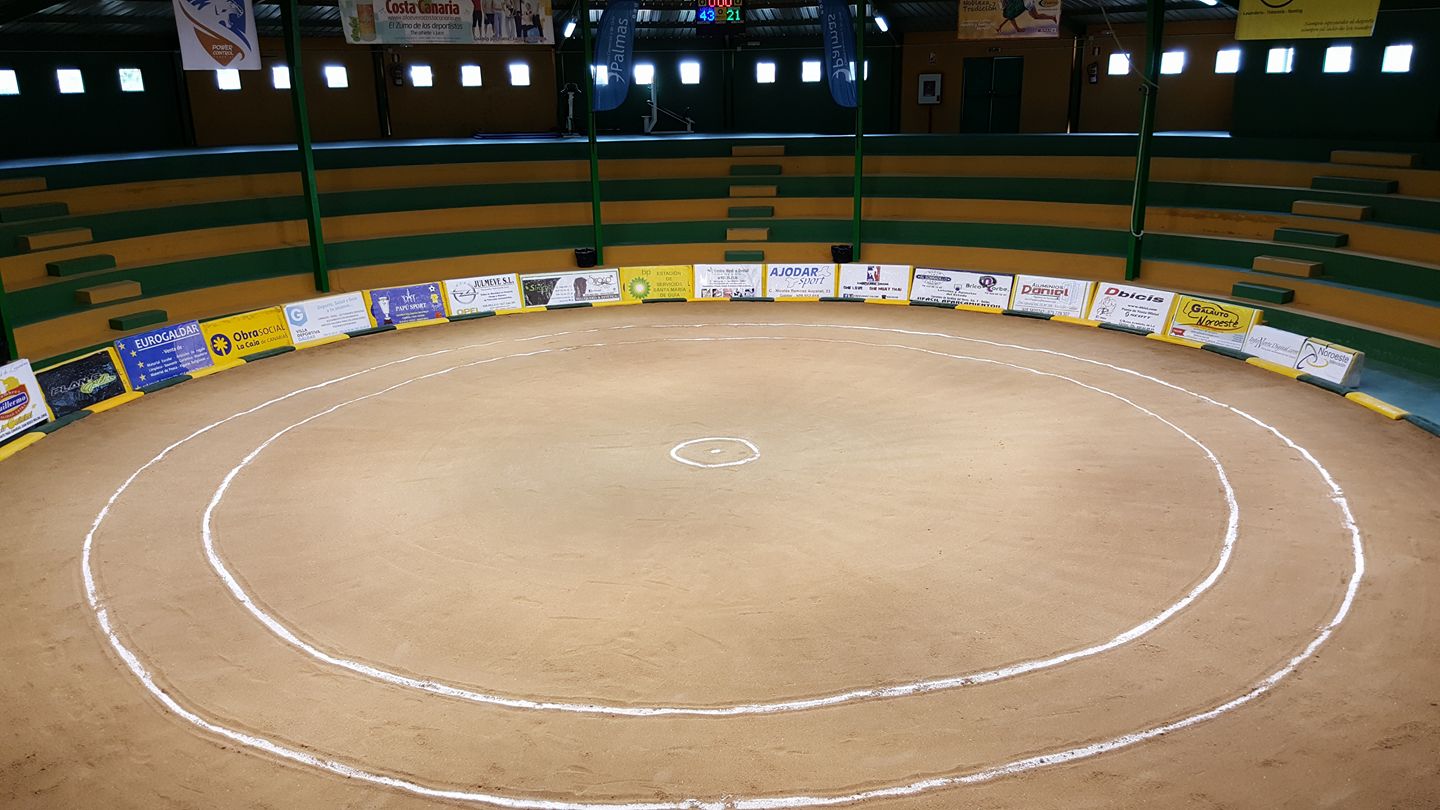
- Current status:
In recent years, the development of Canary stocks has been observed. There are various campaigns promoting programs supported eg by Cabildo di Tenerife. In particular regions and throughout the archipelago, there are numerous professions that the Federacion de Lucha Canaria is responsible for. Moreover, clubs participate in league and cup. Every club earns points in the general classification to reach the title at the end of the each season.
- Contacts:
Federación de Lucha Canaria
Webside: http://www.fedluchacanaria.com/federacioncanaria/
Eail:This email address is being protected from spambots. You need JavaScript enabled to view it.
Address: Callejón Cementerio, s/n - 38360 - Santa Cruz de Tenerife
Tel.: +34 922 251 452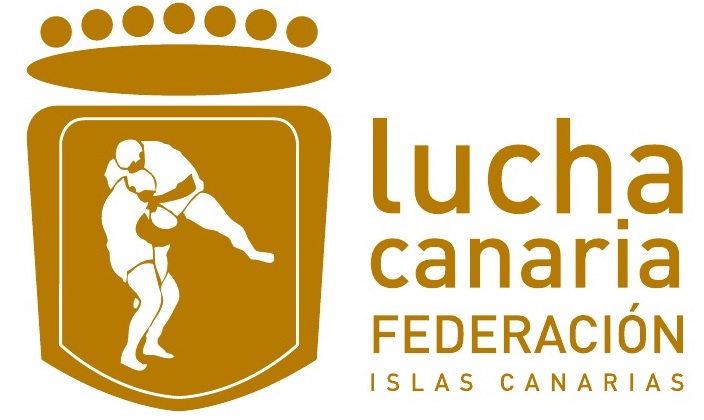
Federación de Lucha Canaria de Lanzarote
Webside: http://federaciondeluchacanariadelanzarote.com/
Fb: https://www.facebook.com/flclz/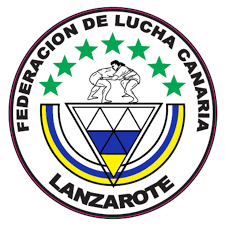
Federación Insular de Lucha Canaria de El Hierro
Fb: https://www.facebook.com/Federaci%C3%B3n-Insular-de-Lucha-Canaria-de-El-Hierro-649688565134721/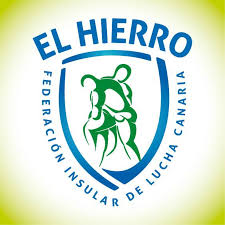
Federación de Lucha Canaria de Gran Canaria
Address: Calle Fondos de Segura s/n, 35019 Las Palmas de Gran Canaria
Phone: +34 928 20 75 31, +34 928 20 75 30
Fb: https://www.facebook.com/fedluchagc/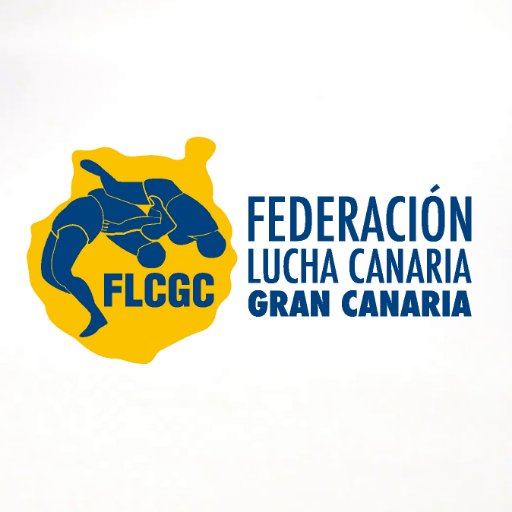
Federación Insular de Lucha Canaria de Tenerife
Address: Call Adán Martin, 15; CP 38208, La Laguna, España
Tel.: +34 662 65 44; +34 922 25 72 55
Email:This email address is being protected from spambots. You need JavaScript enabled to view it.
Webside: http://www.fdlctenerife.es
Fb: https://www.facebook.com/Federaci%C3%B3n-de-Lucha-Canaria-de-Tenerife-404050219674397/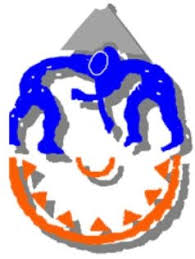
Federación Insular de Lucha Canaria de La Palma
Address: C/ Francisca de Gazmira nº25 (2ºplanta) Edif. Usos Múltiples 38760, Los Llanos de Aridane, La Palma
Tel.: +34 922 46 18 61
Email:This email address is being protected from spambots. You need JavaScript enabled to view it.
Webside: http://flclapalma.com/
Fb: https://www.facebook.com/Federaci%C3%B3n-Insular-de-Lucha-Canaria-La-Palma-147606715401139/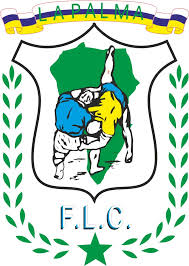
Federación Insular de Lucha Canaria de Fuerteventura
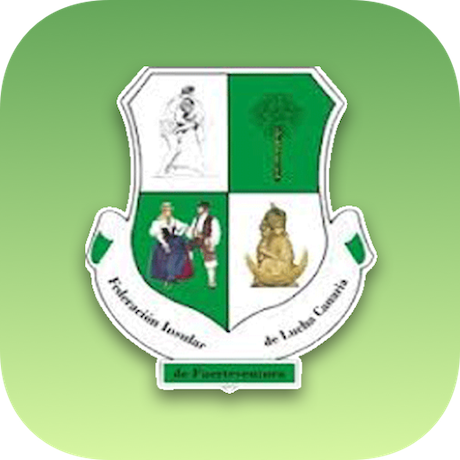
- Sources of information :
• Alberto Orgaz Pérez, Ángel Palanco Aguilera, Manuel Porras García, Daniel Rivas Flores, Patrimonio Histórico Español del juego y del Deporte: Federación de Lucha Canaria, 2010
• Antonio Ayala, La lucha canaria, Mancomunidad de Cabildos de Las Palmas, Paln Cultural, 1977
• Francisco J. Antequera Amor, La lucha canaria en La Palma, Confederación de Cajas de Ahorros, 1989
• J. Morales Magyín, La Lucha Canaria, Ed. Centro de la Cultura Popular Canaria, La Laguna, 2004
• Joaquín Martínez del Reguero, La lucha canaria: una época dorada, Centro de la Cultura Popular Canaria, 1998
• José Hernandez Moreno, Lucha canaria: la preparación física del luchador, Dirección General de Deportes, 1989
• José Miguel Martin, La lucha canaria, sí, VeredaLibros, 2016
• José Peraza Lorenzo, Historia gráfica de la lucha canaria en Tenerife, siglo XX, Colectivo de Promotores de la Fundación Canaria de Lucha, 2007
• Juan Jeronimo Perez, Lucha Canaria, Santa Cruz de Tenerife: PEKIS, 1967
• Juan José Pacheco Lara (coordinator), Propuesta metodológica para la enseñanza de la Lucha Canaria en la educación básica, Gobierno de Canarias, 2010
• Pedro González Marrero, Iniciación a la Lucha Canaria, 1990
• Salvador Sanchez Garcia, Lucha Canaria, Teatro, Narrativa, Poesia, Ediciones del Cabildo Insular de Gran Canaria, 1995Articles:
History of Lucha Canaria - http://www.revistabinter.com/2016/11/02/historia-lucha-canaria/
https://www.isladetenerifevivela.com/2011/12/lucha-canaria.html
https://deportesdecontacto.online/lucha-canaria/?fbclid=IwAR39M580TyISj0kBKLAOiM_ePUBsu1lBAoKpuAGjkVXJDy0ecDS_HvncrpYVideo:
https://www.youtube.com/watch?v=EsUSVmqoIaQ
https://www.youtube.com/watch?v=DzKRh6h9uUc
https://www.youtube.com/watch?v=FObHPZ3vdkA
https://www.youtube.com/watch?v=EsUSVmqoIaQ&fbclid=IwAR3Tdr8RLOlS67JF9aaJ7p05vUvyRMCncnRwNadeMAY6EoLy6xXxvLW9iqY
Historia de Lucha Canaria - https://www.youtube.com/watch?v=fTodHQK4q1c (Parte I) - Gallery:
- Documents:
 Estatutos_2018_La_Federacin_de_Lucha_Canaria.pdf
Estatutos_2018_La_Federacin_de_Lucha_Canaria.pdf PATRIMONIO_HISTRICO_ESPAOL_Lucha_Canaria.pdf
PATRIMONIO_HISTRICO_ESPAOL_Lucha_Canaria.pdf Reaglas_del_deporte_de_Lucha_Canaria.pdf
Reaglas_del_deporte_de_Lucha_Canaria.pdf

